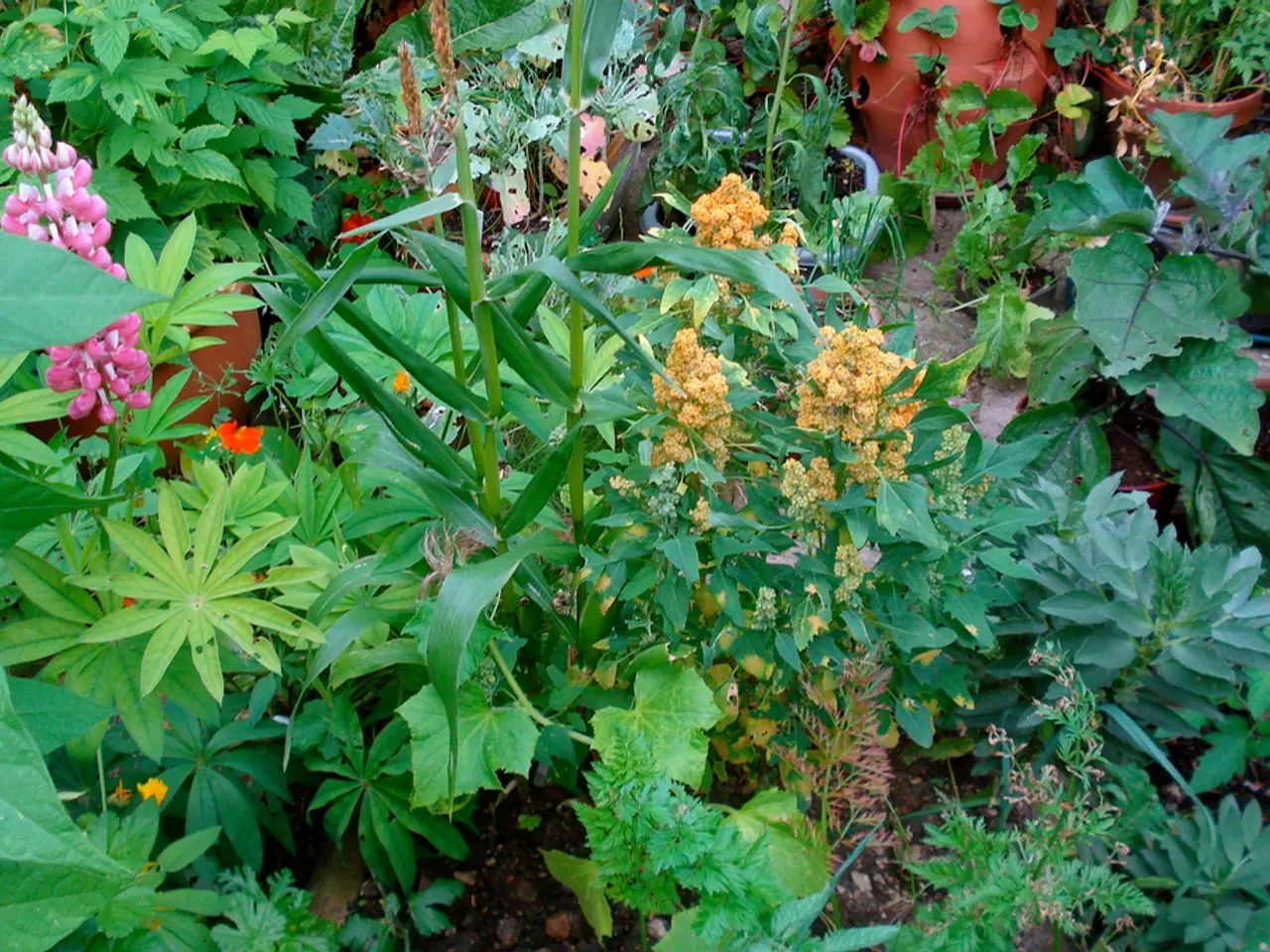Introduction to Pollination Processes
In the vibrant, diverse world of nature, flowering plants - also known as angiosperms - hold a unique place. These plants, characterised by their reproductive structures and enclosed seeds within fruits, play a crucial role in our daily lives.
The Anatomy of Flowering Plants
At the heart of a flowering plant, you'll find four main whorls: the sepal, petal, stamen, and carpel or pistil. The sepal acts as an outer protective layer, while the petal, often colourful and fragrant, attracts pollinators. The stamen, the male reproductive organ, produces pollen, and the carpel or pistil, the female reproductive organ, contains the ovary, style, stigma, and ovules [1][3][5].
The Intricate Reproductive Process
The life cycle of flowering plants involves a complex reproductive process. Within the flower, reduced gametophytes - the male gametophyte (pollen grain) consisting of only two cells, and the female gametophyte developing into a seven-cell, eight-nucleus structure within the ovule inside the ovary - play a key role [4].
Unlike other plants, flowering plants undergo double fertilization. One sperm fertilizes the egg to form the zygote, and another sperm fertilizes another cell to form the endosperm, a food source for the developing embryo [4].
After fertilization, the ovary matures into a fruit, which protects and disperses the seeds [4].
Differences in Life Cycle and Pollination
Flowering plants and other plants, such as gymnosperms and ferns, differ in their reproductive structures, gametophyte size, fertilization process, seed protection, and pollination agents [2].
| Aspect | Flowering Plants (Angiosperms) | Other Plants (e.g., Gymnosperms, Ferns) | |-------------------------|---------------------------------------------------------|----------------------------------------------------------------| | Reproductive Structure | Flowers with stamens and pistils | Cones (gymnosperms), spores (ferns and mosses) | | Gametophyte Size | Very reduced (2-celled male, 7-celled female) | Larger and multicellular gametophytes | | Fertilization | Double fertilization forming zygote and endosperm | Single fertilization; no endosperm formation | | Seed Protection | Seeds enclosed within a fruit (from ovary) | Seeds exposed or in cones, no true fruit | | Pollination Agents | Often animals (insects, birds, bats) attracted by petals | Mostly wind; usually not animal-pollinated | | Pollination Process | Pollen deposited on stigma; often specialized for cross-pollination; some self-pollination mechanisms exist | Pollen usually delivered to ovules by wind |
The Role of Pollination
Flowering plants have evolved flowers with colourful petals and nectar to attract animal pollinators, enhancing genetic diversity through cross-pollination. In contrast, many other plant groups rely primarily on wind pollination or spores for reproduction [1][2][4].
The Importance of Pollination in New Zealand
In New Zealand, the decline in native bird populations can have a negative impact on flowers that rely on them for pollination. Honey bees, however, are the main pollinators of many cultivated food crops, and artificial pollination is often used for kiwifruit to ensure good crops. Some fruit crops, such as kiwifruit and avocados, are not getting pollinated enough [6].
Engaging with Pollination
To deepen understanding in the areas of pollination and fertilisation, and flowering plant life cycles, students can participate in hands-on activities such as observing flowers, role-play, matching native flowers with their pollinators, interpreting and annotating diagrams, and locating and interpreting scientific information [7].
A unit plan for lower primary students is available for teaching about pollination, and a question bank provides an initial list of questions about pollination and their answers [8]. Seeds of flowering plants are spread away from the parents and grow into new plants in new places [9].
The Future of Pollination
Scientists are investigating why certain fruit crops are not getting pollinated enough, and research is underway to develop technologies like the RoboBee to improve artificial pollination [10].
As we continue to unravel the mysteries of flowering plants and their pollination processes, we ensure a sustainable future for these vital plants and the food they provide.
[1] Science Learning Hub. (2016). Inquiry into pollination. Retrieved from https://www.sciencelearn.org.nz/resources/1488-inquiry-into-pollination
[2] Pollination resources - planning pathways. (n.d.). Retrieved from https://www.sciencelearn.org.nz/resources/1127-pollination-resources-planning-pathways
[3] Botanical Society of Britain and Ireland. (n.d.). Flower structure. Retrieved from https://www.bsbi.org/learn/flower-structure
[4] Pollen and the process of pollination. (n.d.). Retrieved from https://www.sciencelearn.org.nz/resources/452-pollen-and-the-process-of-pollination
[5] The pollination process. (n.d.). Retrieved from https://www.sciencelearn.org.nz/resources/1126-the-pollination-process
[6] New Zealand scientists investigating why some fruit crops not getting pollinated enough. (2021, March 16). Retrieved from https://www.stuff.co.nz/business/123190349/new-zealand-scientists-investigating-why-some-fruit-crops-not-getting-pollinated-enough
[7] Science Learning Hub. (2016). Inquiry into pollination. Retrieved from https://www.sciencelearn.org.nz/resources/1488-inquiry-into-pollination
[8] Pollination - question bank. (n.d.). Retrieved from https://www.sciencelearn.org.nz/resources/1128-pollination-question-bank
[9] Seeds - what are they and how do they grow? (n.d.). Retrieved from https://www.sciencelearn.org.nz/resources/449-seeds-what-are-they-and-how-do-they-grow
[10] A RoboBee to improve artificial pollination. (2018, September 13). Retrieved from https://www.bbc.com/future/article/20180913-the-robo-bee-that-could-pollinate-crops
- The role of flowering plants in health-and-wellness extends beyond our physical wellbeing as they are crucial in the health of the environment through processes like cross-pollination, contributing to a diverse ecosystem.
- The intricate reproductive process of flowering plants includes double fertilization, resulting in a zygote and endosperm, a unique characteristic compared to other plant groups such as gymnosperms and ferns.
- Research in scientific fields like environmental-science and environmental-biology, such as the investigation of RoboBee technology for artificial pollination, aims to guarantee a sustainable and healthy-diet future, with enough nutrient-rich fruits and vegetables for all.
- The study of space-and-astronomy may provide insights into the evolution and distribution of flowering plants on Earth, showing the interconnectedness between different areas of science, like climate-change and fitness-and-exercise, ultimately aiding in our understanding and preservation of the environment.




